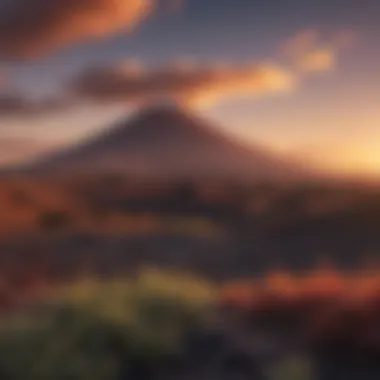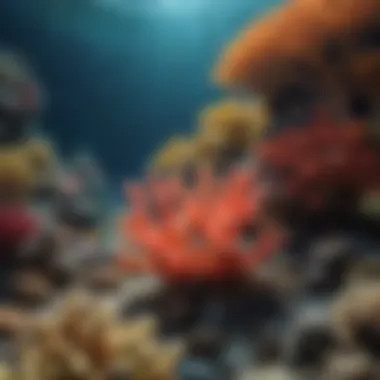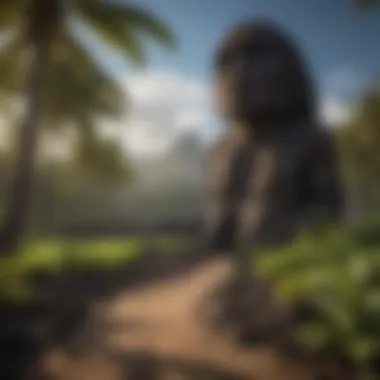Discovering the Big Island of Hawaii: Name and Importance


Nature Topic Overview
The Big Island of Hawaii is a fascinating gem tucked away in the Hawaiian archipelago. It’s the youngest and largest island in the series, offering a beautiful blend of landscapes and ecosystems. The island's full name, Hawaii Island, often leads to a bit of confusion, as many simply call it Hawaii, which is also the name of the entire state. Despite these mix-ups, this island stands out due to its unique features, rich history, and cultural significance.
The sheer size of the Big Island means it showcases a variety of environments, from lush rainforests and vibrant coral reefs to stark volcanic landscapes. Understanding its place in nature reveals its importance not just as a tourist destination but also as a vital ecological haven. This overview takes you on a journey through its natural wonders and cultural significance.
Fun Facts and Trivia
Did you know that the Big Island is home to Mauna Kea, which is taller than Mount Everest when measured from its base on the ocean floor? This island just keeps surprising you! Here are a few more interesting tidbits:
- The Big Island hosts 11 of the world’s 13 climate zones.
- It has two active volcanoes, Kilauea and Mauna Loa, showing how alive this place truly is.
- The island offers stargazing opportunities like no other, especially from Mauna Kea’s summit.
These facts not only intrigue young minds but also set the stage for deeper exploration.
Wildlife Explorations
The diversity of wildlife on the Big Island is astounding. Various ecosystems support numerous species unique to Hawaii. For young readers eager to explore, here are some amazing creatures to learn about:
- Hawaiian Monk Seal: One of the few seal species found in tropical waters.
- Humpback Whales: Each winter, these magnificent mammals migrate to Hawaiian waters to breed.
- Nene Goose: The state bird of Hawaii, this goose has adapted exceptionally to the island's landscapes.
Learning about these animals can spark interest in ecology. Maybe you could even create a quiz about Hawaii’s wildlife with questions like:
- What is the largest mammal to migrate to Hawaii?
- How many species of endangered animals live on the Big Island?
Environmental Awareness
The Big Island is a vivid reminder of nature's fragility. Conservation plays a vital role in preserving its treasures for future generations. Children can also play a part in protecting this beautiful place by:
- Understanding the impact of pollution on coral reefs.
- Participating in local beach clean-ups.
- Learning about the importance of native plants and animals in the ecosystem.
Fostering awareness among youngsters about the balance of nature inspires action, encouraging them to cherish and protect the environment.
DIY Nature Activities
To take learning further, hands-on activities make it engaging and fun. Here are some ideas:
- Create a Mini Volcano: Using baking soda and vinegar, let the kids observe a simple reaction change that mimics volcanic eruptions.
- Nature Collage: Collect leaves, flowers, and small rocks to create a collage representing the island's diverse natural beauty.
- Outdoor Exploration: Organize a nature hike where children can observe local flora and fauna, perhaps even documenting sightings in a nature journal.
These activities not only reinforce the knowledge gained but also nurture creativity and a love for the great outdoors.
By exploring the Big Island of Hawaii, children can connect with its natural wonders and learn about their role in protecting our planet. The stories and lessons wrapped in Hawaiian culture are as vibrant and varied as the island itself.
Prologue to the Big Island
The Big Island is more than just a geographical space; it is a canvas painted with rich history and vibrant culture. Understanding the Big Island is like peeling an onion, with each layer revealing deeper significance. This section sets the stage for exploring the profound connection between its name and the stories it enshrines.
Geographical Overview
The size and shape of the Big Island
The Big Island stands out with its immense size, being the largest island in the Hawaiian chain. Stretching over 4,000 square miles, it's bigger than all the other islands combined. Its shape resembles a triangle, which adds to its uniqueness. This size contributes to its diverse ecosystems, providing various habitats that support a plethora of species.
The sheer expanse of the Big Island offers a broad array of landscapes, such as volcanic craters, lush rainforests, and beautiful beaches. This variety attracts visitors, making it a key spot for eco-tourism. The island's size also means there is plenty of room to explore, which is ideal for families looking for adventures in nature.
Location in the Hawaiian archipelago
Located at the southeastern tip of the Hawaiian Islands, the Big Island's position is vital. It is the furthest from the mainland United States but is readily accessible via air travel. Being situated here gives it a unique climate, often referred to as the "rain shadow effect“, where one side is lush and green while the other can be arid.
This geographic position allows for diverse environmental experiences within a single destination, greatly appealing to budding adventurers and nature lovers. Kids can learn about how climate plays a role in shaping environments by merely traveling a short distance across the island.
Significance of its geology


Geologically, the Big Island tells a story of volcanic activity. Its formation, primarily from five volcanoes, showcases the Earth’s forces at work and provides a living laboratory for educational exploration. The presence of Mauna Loa, the world’s most massive volcano, and Kilauea, one of the most active ones, signifies a dynamic landscape.
The geology affects everything from soil types to plant life, making it crucial for understanding biodiversity on the island. Young learners can discover how different geological features host distinct ecosystems. This awareness encourages a deeper appreciation for conservation as children connect the dots between nature's makeup and its preservation.
Naming the Big Island
Literal meaning of ‘Hawaii’
The name “Hawaii” has origins that encapsulate the spirit of the islands. Many believe it comes from "Hawaiki," a mythical homeland from Polynesian lore. "Hawaii" itself signifies a home, a notion that resonates deeply with residents. This literal meaning plays a role in the identity of the Big Island, presenting it as a welcoming land for its inhabitants and visitors.
This interpretation lends itself to concepts of belonging and environmental stewardship. Children learning about the name may feel more connected and inclined to respect the island's natural beauty and traditions.
Historical context of the name
The history of the name “Hawaii” can be traced back to ancient times when voyagers first settled on these islands. Each new wave of settlers brought stories and meanings, enriching the cultural tapestry. The name gained official recognition with King Kamehameha I, who united the islands under one rule in the late 18th century.
Understanding this historical context allows young minds to appreciate how names can evolve and carry significance. It shows the importance of history in shaping identity. Recognizing who they are helps young readers foster a sense of pride in their heritage.
Cultural significance and folklore
The folklore surrounding the name “Hawaii” is full of stories that intertwine nature and people. Many tales speak of gods, goddesses, and spirits that roamed the land and islands, creating a rich cultural backdrop. These stories bring life to natural features, such as mountains or rivers, and enable children to see the magic in their surroundings.
This section also emphasizes the importance of oral traditions in preserving heritage. Understanding cultural narratives enriches the learning experience for kids, fostering an appreciation for different perspectives and values of indigenous peoples. Their connection to nature is not just physical; it is also deeply spiritual.
Natural Features of the Big Island
The Big Island is a treasure trove of natural wonders that captivates and inspires. Its diverse landscapes, shaped by volcanic activity, are not just iconic; they tell a story of the Earth’s ever-changing nature. This section zooms in on the natural features that define the Big Island, making it a significant part of the Hawaiian experience.
Volcanoes and Landscapes
Mauna Loa and its prominence
Mauna Loa stands tall, quite literally, as one of the most prominent volcanoes not just in Hawaii, but across the globe. Stretching over 13,000 feet above sea level, it’s a giant with a gentle demeanor, often missing the explosive outbursts seen with other volcanoes. Instead, Mauna Loa is like a large canvas, smooth and seemingly endless. Its sheer size is a draw for scientists and adventurers alike. By studying this volcano, visitors learn about the life cycles of volcanoes and how they shape our planet.
Mauna Loa’s unique characteristic is its gradual slopes, giving it a gentle stature rather than a steep peak. This shape provides a safe area for hiking and exploration. However, when considering safety, understanding that Mauna Loa can still erupt is crucial. Visitors need to always check local alerts before planning their journey to the summit.
Kilauea: A living volcano
Kilauea is often called a living volcano because it’s continuously active and purring like a cat. Unlike its brothers, Kilauea, which means "much spreading", has been erupting on and off for centuries. Its lava flows have created new land and changed the island's geography numerous times. By observing Kilauea, people see the raw power of nature firsthand. In 2018, Kilauea had an immense eruption which shaped the island anew.
One of Kilauea’s most fascinating features is the Halemaʻumaʻu Crater, where visitors can occasionally see glowing lava lakes. This draws visitors, making it beneficial for educational purposes, raising awareness about volcanology, and showing how volcanic systems work. However, the dangers associated with active volcanoes must also be acknowledged. Safety should always come first when enjoying its beauty.
Diverse terrains: From beaches to mountains
The Big Island’s terrain is a storybook, ranging from pristine beaches to soaring mountains. This diversity offers an abundance of opportunities for exploration and adventure. You can bask in the sun on golden sands or hike through lush forests. Each landscape showcases the island's beauty in a unique light.
The variety of terrains means that everyone's interests can be catered to—from families hitting the beach for a day of fun to hikers seeking thrills on the rugged terrain. However, this vastness does present a challenge: navigating the different environments can be tricky. Visitors are encouraged to plan their routes carefully and to pack appropriately for varying conditions.
Flora and Fauna
Endemic species of plants
The Big Island is home to a wealth of endemic plant species, plants that cannot be found anywhere else in the world. Among these are the beloved ʻōhiʻa lehua and the vibrant Hawaiian hibiscus. These plants paint the landscape in vibrant colors and play crucial roles in their ecosystems, supporting various forms of life.
The importance of endemic plants lies in their adaptability to the unique environment of Hawaii. They help stabilize the soil and provide food for native animals. However, these species face threats from invasive plants and habitat loss, making it vital for conservation efforts to protect them.
Animals unique to the Big Island
The Big Island also serves as a sanctuary for animals that have adapted uniquely to this environment. The nene goose, for instance, is the state bird and represents a remarkable success story in conservation. Its comeback from near extinction highlights the essential role of habitat preservation.
Unique characteristics of these animals are often tied to their evolution in isolation. Learning about these creatures sparks curiosity in children, inspiring the next generation of conservationists. Nevertheless, understanding these animals requires learning about their habitats and the threats they face.
The importance of biodiversity


Biodiversity refers to the variety of life on Earth and is a crucial aspect of the Big Island. This diversity contributes to a balanced ecosystem, which can withstand changes over time. The intricate web of relationships among plants, animals, and their environments is impressive and delicate.
Highlighting the importance of biodiversity helps everyone realize that all species, no matter how small, play a role in maintaining the ecosystem's health. However, preserving this biodiversity is an ongoing challenge. Climate change and habitat destruction loom large, necessitating a collective effort to safeguard this natural heritage for future generations.
Cultural Aspects of the Big Island
The cultural landscape of the Big Island is as rich as its volcanic soil. Understanding the cultural aspects is pivotal as they underline the essence of Hawaiian identity. The traditions, customs, and historical landmarks speak volumes about the people and their relationship to the land. This section will delve into Hawaiian beliefs, the significance of hula and chant, and the vibrant cultural festivals that color life on the island. These elements not only enhance the island's appeal but also serve an educational purpose for young readers who wish to learn about conservation and respect for nature.
Hawaiian Traditions and Customs
Traditional Hawaiian beliefs
At its core, Traditional Hawaiian beliefs are deeply intertwined with nature. The relationship between the Hawaiian people and their environment is sacred. This spirituality emphasizes that everything is connected—plants, animals, and even the land itself. One key characteristic of these beliefs is the importance of ‘Aumakua, which translates to ancestral spirits. These spirits guide families and are often represented by animals or plants, creating a profound sense of continuity and respect for the world around them.
This belief system encourages a beneficial relationship with the environment, fostering sustainable practices. Children who learn about these traditions can gain a deeper appreciation for their surroundings, understanding the advantages that such an outlook can offer. They learn not only about the island's ecology but also about the rich narrative that ties them to each facet of nature.
Significance of hula and chant
Hula and chant, or oli, play a pivotal role in expressing Hawaiian culture and history. These art forms are not merely entertainment but serve as a historical record, conveying stories of gods, ancestors, and the land itself. The key characteristic of hula is its dance movements, which reflect the rhythm of the chant, further emphasizing the connection between body and spirit.
In our exploration, recognizing the significance of these cultural practices reinforces how storytelling transcends language. It awakens a sense of identity and belonging, making it a popular choice for children to learn about and celebrate. While hula often incorporates visuals and rhythm, the chants delve deeper into the emotions and lessons learned from the past. The unique feature of these performances is their communal nature, creating a bond among participants and audiences alike, serving as an educational tool for all involved.
Cultural festivals on the Big Island
Cultural festivals on the Big Island are not just events; they are celebrations of identity and heritage. These gatherings present a unique opportunity for families to come together, share traditions, and enjoy local food and crafts. One significant festival, the Merrie Monarch Festival, celebrates hula, featuring competitions that attract islanders and tourists alike.
The benefit of participating in these festivals extends beyond enjoyment; it fosters a sense of collective memory and community involvement. Young attendees participate in activities that teach them about their culture, instilling pride in their heritage. Moreover, the festivals create an environment that teaches the next generation about conservation, as many local artisans focus on sustainable practices in their crafts.
Historical Landmarks
With a history that dates back centuries, the Big Island boasts remarkable landmarks, each telling its own story. These sites are vital for understanding Hawaiian culture and history, as they reveal the intertwined relationship between the people and their land. The next section will highlight some important historical landmarks, ensuring a comprehensive view of the island's rich legacy.
Pu'uhonua o Honaunau National Historical Park
Pu'uhonua o Honaunau National Historical Park is a symbol of refuge and restoration. It offers insight into life in pre-colonial Hawaii. This area features sacred places where those who broke laws could seek forgiveness and safety. The unique aspect of the park is its preserved structures, such as the heiau and the kapu system, alongside displays of ancient crafts and practices.
Its role in educating youth on Hawaiian laws and values is imperative, as it teaches respect for both people and the land. The park serves as a reminder of how traditions can be upheld and cherished through knowledge and understanding.
Petroglyphs and their meanings
The petroglyphs found scattered across the island are ancient carvings that provide a window into Hawaiian ancestral lives. Each symbol carved in stone carries meaning, often linked to family lineage, land ownership, or spiritual beliefs. Their discovery invites classifications and interpretations, helping to form connections between the past and present.
This unique feature of petroglyphs rests on their ability to spark curiosity among children. When young explorers learn about these carvings, they engage with a tangible piece of history. Encouraging discussions around the meanings fosters critical thinking and a deeper appreciation for cultural narratives.
The royal heritage of Hawai'i
The royal heritage of Hawaii is steeped in history. The legacy of King Kamehameha and his descendants is woven into the fabric of the island's identity. Understanding this heritage provides valuable context for modern Hawaiian culture.
This royal lineage shapes community values and national pride, presenting a unique aspect of the Big Island’s culture that deserves attention. Children can connect with stories of bravery and leadership, encouraging them to appreciate the lessons learned from history. While exploring these tales may seem distant, it instills a sense of connection to place and heritage that is both meaningful and educational.
"Those who do not remember the past are condemned to repeat it."
The Big Island, steeped in cultural richness and heritage, invites exploration and understanding. Its traditions, customs, and landmarks guide the journey, offering a vibrant tapestry of lessons for young learners. Keeping all this in mind, the next section will delve into conservation efforts taking place on this stunning island.
Conservation Efforts
Conservation is crucial on the Big Island of Hawaii due to its diverse ecosystems and endangered species. Protecting the natural environment ensures not just the survival of unique flora and fauna, but also the well-being of the people who live there. Various efforts are focused on sustaining the delicate balance of nature, promoting awareness, and engaging the community. It's a matter of preserving paradise while fostering responsible stewardship among residents and visitors alike.
Protecting Endangered Species
Efforts to save native birds
Hawaii is home to a variety of native birds, many of which are endangered. For instance, the Hawaiian Goose, or Nene, has seen significant conservation efforts aimed at increasing its population. Programs include habitat restoration and breeding in captivity, which significantly contribute to boosting numbers. Protecting these species isn't just about saving birds; it's about maintaining the integrity of the ecosystems they inhabit. The unique feature of these efforts is the hands-on approach taken by volunteers, who often engage in monitoring bird populations and banding programs. While these initiatives are beneficial, they sometimes face challenges like habitat loss and climate change, which can hinder their success.


Restoration of native plant ecosystems
Another important aspect of conservation involves restoring native plant ecosystems. These initiatives aim to bring back native flora that serves as vital habitat for native wildlife and contributes to the island's beauty. Efforts typically focus on reintroducing endemic plants, which can flourish in their natural habitats. By focusing on native species, these restoration projects help maintain soil health and prevent erosion, which benefits the entire ecosystem. However, it’s important to note that restoring ecosystems can be a lengthy process, requiring patience and continuous effort from dedicated teams.
The role of community in conservation
Community involvement plays a pivotal role in conservation on the Big Island. Local organizations and residents come together for various initiatives like clean-up drives and tree planting events. This collective effort not only beautifies the landscape but also fosters a sense of ownership over the environment. The major characteristic of community-led conservation is the grassroots mobilization, which has proven to be a cost-effective way of making a difference. Still, while community engagement brings numerous advantages, apathy among some individuals can pose ongoing challenges to sustaining these long-term efforts.
Educational Programs and Resources
Engaging children in nature
Engaging children in nature is foundational for fostering a love for the environment. Programs often aim to inspire young minds by helping them explore local ecosystems, learn about wildlife and understand conservation efforts. Such hands-on experiences enhance appreciation for nature and produce lasting memories. The unique aspect of these activities is the interactive environment that encourages curiosity and exploration. However, while many kids thrive in these settings, some may feel overwhelmed by too much information or may need tailored approaches to encourage their willingness to participate.
Classes at local parks and facilities
Local parks and facilities often host classes designed to educate children about the island’s ecosystems and wildlife. These classes cover a variety of topics including nature photography, turtle conservation, and more. The primary advantage of such classes is the blend of fun and learning that captivates children’s imaginations while providing them noteworthy skills. Often, these classes encourage kids to form lasting bonds with nature. However, accessibility can be a concern, especially for families with limited resources.
Utilizing digital resources for learning
In today’s digital age, utilizing digital resources for learning about conservation has become increasingly important. Many educational platforms now offer interactive materials and games that make learning about flora and fauna enjoyable and engaging. This benefit is that kids can explore the Big Island's unique environment from anywhere. However, it’s crucial to maintain a balance between screen time and outdoor experiences, as both play important roles in educating children about conservation and nature.
Community efforts are essential for the future of the Big Island and its rich biodiversity. By engaging children and involving families, we create a shared responsibility toward environmental stewardship.
The Future of the Big Island
Thinking about the future of the Big Island of Hawaii involves more than just considering what’s ahead. It connects to how we, as a society, choose to blend our lives with this stunning environment. The island faces numerous challenges, from environmental shifts to the pressures of tourism. Maintaining its beauty while ensuring that future generations can enjoy it is important. By focusing on sustainable practices, young folks can actively participate in caring for this jewel in the ocean.
Sustainable Practices
Eco-tourism initiatives
Eco-tourism on the Big Island is an approach that aims to keep nature in its prime. Local communities often back these initiatives, which lets them earn from visitors while protecting the environment. A key characteristic is how these programs prioritize not just enjoyment, but education about the surroundings. When tourists take part in sustainable tours, they learn why preserving nature is crucial.
One unique feature of eco-tourism here could be guided hikes in places like the 'Akaka Falls State Park, where visitors are taught about the local ecology. The advantage? Folks leave with a better understanding of the area and a desire to help protect it. However, too many visitors in sensitive areas might lead to damage, so it needs careful planning.
Renewable energy sources
The Big Island is moving towards renewable energy sources to reduce reliance on fossil fuels. This is essential for reaching sustainable goals. The island is blessed with plenty of sunlight and wind, which makes it easier to harness energy. One key characteristic of this initiative is local investment in solar panels and wind turbines. By embracing renewable energy, the island can have cheaper electricity and lessen its carbon footprint.
A unique aspect of renewable projects could be the community solar farms where locals can invest. This benefits the population by allowing them to save on energy bills while promoting green technology. On the flip side, transitioning too quickly without proper systems in place can cause disruptions and confusion.
Community-led sustainability projects
Community-led sustainability projects are grassroots movements where local people take charge of conservation efforts. This means more voices can be heard, which is especially valuable. A key feature is the encouragement of local schools to take part in hands-on projects, such as beach clean-ups or planting trees. These activities not only clean the environment but also nurture a connection with it among participants.
One striking advantage of community projects is the collaborative effort that strengthens relationships between residents. It builds a sense of ownership over the local landscape. However, some projects might encounter challenges with funding and community input, making it essential to find a balance between ideas and practical execution.
Encouraging Young Conservationists
How children can contribute
Children play a significant role in the future of conservation on the Big Island. Simple actions like recycling at school or participating in weekly beach clean-ups can make a huge difference. One key characteristic of engaging kids is that it empowers them, showing that their actions matter. Small contributions can pile up into something big over time.
A unique feature of these efforts could be organized youth groups that plan monthly activities. This kind of involvement is beneficial as it builds teamwork and encourages long-term commitment. Although they might lack experience at first, these young minds come with fresh ideas full of passion.
Fostering a sense of stewardship
Fostering a sense of stewardship means teaching our kids to care for the environment as if it’s their home. This approach connects deeply with values and responsibility. A key aspect here is finding creative ways to encourage kids to interact with nature; for example, classroom learning paired with field trips to places like Hawaii Volcanoes National Park. This hands-on experience can cement their understanding of conservation.
A unique quality of stewardship programs could be mentorship from local conservationists, allowing children to ask questions and develop personal connections to environmental issues. However, if children don’t see immediate results from their efforts, they might get disheartened, emphasizing the need for gradual success stories to be shared.
The role of outdoor education
Outdoor education offers valuable experiences that foster a passion for the environment. This approach allows kids to learn through exploration instead of only in the classroom. One key characteristic is its interactive nature, making learning feel less like a chore. When kids experience nature firsthand, they often grow a lasting love for it.
A unique aspect of outdoor education programs could be training sessions where children learn to identify native plants and animals. This helps them appreciate local biodiversity, which also has its advantages for adults involved. As a downside, sometimes these programs might lack resources or structured schedules, but the excitement of being outdoors often outweighs those issues.
"Engaging with nature can not only educate our youth but can also shape their future choices on how to protect and preserve their home, the Big Island."







